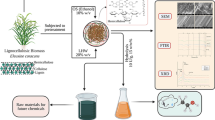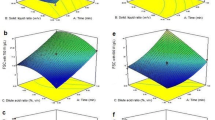Abstract
One of the targets of the Sustainable Development Goals is clean and affordable energy. This is also the aim of the Biofuels Act of 2007 in the Philippines. However, this law is confronted with challenges such as the limitation of lignocellulosic feedstock, specifically available for bioethanol production. The present study sought to address the issue by exploring the potential of mango seed husk (MSH), a by-product of the mango industry, in bioethanol production. MSH is considered a waste material and its utilization also permit value-addition as this can serve as an alternative and affordable source of feedstock in energy production. Two pretreatment strategies are employed to exploit the cellulose and hemicellulose content of MSH, namely, dilute acid treatment and enzymatic hydrolysis. Results show that the %H2SO4 resulting in the highest glucose concentration and yield is 4% v/v at 95 °C hydrolysis temperature, 1:10 (w/v) solid-to-solvent ratio, and 60-min hydrolysis time. For enzymatic hydrolysis using a commercial enzyme preparation, the reaction time up to 72 h did not affect glucose concentration and yield at the following conditions: 50 °C hydrolysis temperature, 150 rpm, pH 5.0, 10% solids loading, and 4% enzyme loading. This could be attributed to the lignin and non-structural compounds present in MSHs. However, a combined process strategy of dilute acid pretreatment followed by enzymatic hydrolysis in the pretreatment of MSH contributes to an increased concentration and yield of sugars in the hydrolysates, which is advantageous for bioethanol production.

Graphical Abstract





Similar content being viewed by others
Data Availability
All data generated or analyzed during this study are available from the corresponding author on reasonable request.
References
Corpuz, P. and Bedford, R. (2018). Philippine biofuels situation and outlook. USDA Foreign Agricultural Service Global Agricultural Information Network Report Number RP 1840.
Aditiya, H. B., Mahlia, T. M. I., Chong, W. T., Nur, H., & Sebayang, A. H. (2016). Second generation bioethanol production: a critical review. Renewable and Sustainable Energy Reviews, 42, 631–653.
Mahboubi, A., Ylitervo, P., Doyen, W., de Wever, H., Molenberghs, B., & Taherzadeh, M. J. (2017). Continuous bioethanol fermentation from wheat straw hydrolysate with high suspended solid content using an immersed flat sheet membrane bioreactor. Bioresource Technology, 241, 296–308.
Brinchi, L., Cotana, F., Fortunati, E., & Kenny, J. M. (2013). Production of nanocrystalline cellulose from lignocellulosic biomass: technology and applications. Carbohyd Polym., 94(1), 154–169.
Michelin, M., Ruiz, H. A., Silva, D. P., Ruzene, D. S., Teixeira, J. A., & Polizeli, M. L. T. M. (2014). Cellulose from lignocellulosic waste. Polysaccharides. 1-33.
Chaturvedi, V., & Verma, P. (2013). An overview of key pretreatment processes employed for bioconversion of lignocellulosic biomass into fuels and value added products. Biotech., 3, 415–431.
Performance of Philippine agriculture April–June 2017. Available from https://psa.gov.ph/content/performance-philippine-agriculture-april-june-2017. Accessed 11 March 2019.
Andrade, L. A., Barrozo, M. A. S., & Vieira, L. G. M. (2016). Thermo-chemical behavior and product formation during pyrolysis of mango seed shell. Industrial Crops and Products, 85, 174–180.
Orozco, R. S., Hernandez, P. B., Morales, G. R., Nunez, F. U., Villafuerte, J. O., Lugo, V. L., Ramirez, N. F., Diaz, C. E. B., & Vazquez, P. C. (2014). Characterization of lignocellulosic fruit waste as an alternative feedstock for bioethanol production. BioResources., 9(2), 1873–1885.
Torres-Leon, C., Rojas, R., Contreras-Esquivel, J. C., Serna-Cock, L., Belmares-Cerda, R. E., & Aguilar, C. N. (2016). Mango seed: functional and nutritional properties. Trends in Food Science and Technology, 55, 109–117.
Dalli, S. S., Patel, M., & Rakshit, S. K. (2017). Development and evaluation of poplar hemicellulose prehydrolysate upstream processes for the enhanced fermentative production of xylitol. Biomass Bioenerg., 105, 402–410.
Pal, S., Mondal, A. K., & Sahoo, D. K. (2016). Molecular strategies for enhancing microbial production of xylitol. Process Biochemistry, 51(7), 809–819.
Kou, L., Song, Y., Zhang, X., & Tan, T. (2017). Comparison of four types of energy grasses as lignocellulosic feedstock for the production of bioethanol. Bioresource Technology, 241, 424–429.
Lenihan, P., Orozco, A., O’Neill, E., Ahmad, M. N. M., Rooney, D. W., & Walker, G. M. (2010). Dilute acid hydrolysis of lignocellulosic biomass. Chemical Engineering Journal, 156(2), 395–403.
Ballesteros, M. (2010). Enzymatic hydrolysis of lignocellulosic biomass. In: Bioalcohol production, 1st edition (Waldron, K.W., ed.), Woodhead Publishing, pp.159–177.
Luo, X., Liu, J., Zheng, P., Li, M., Zhou, Y., Huang, L., Chen, L., & Shuai, L. (2019). Promoting enzymatic hydrolysis of lignocellulosic biomass by inexpensive soy protein. Biotechnology for Biofuels, 12(1), 51.
Yang, B., Dai, Z., Ding, S., & Wyman, C. E. (2011). Enzymatic hydrolysis of cellulosic biomass. Biofuels., 2(4), 421–450.
Nielsen, S. S. (2009). Phenol-sulfuric acid method for total carbohydrates. In: Food Science Texts Series (Nielsen, S.S., ed.), Springer, Boston.
ASTM D1762-84 (2013). Standard test method for chemical analysis of wood charcoal. ASTM International, West Conshohocken, PA, 2013.
Sluitzer, A., Ruiz, R., Scarlata, C., Sluiter, J., & Templeton, D. (2005). Determination of extractives in biomass (LAP). National Renewable Energy Laboratory, Golden, CO, USA. NREL/TP-510-42619.
Sluitzer, A., Hames, B., Ruiz, R., Scarlata, C., Sluiter, J., Templeton, D., & Crocker, D. (2012). Determination of structural carbohydrates and lignin in biomass (LAP). National Renewable Energy Laboratory, Golden, CO, USA. NREL/TP-510-42618.
Trindade, W. G., Hoareau, W., Megiatto, J. D., Razera, I. A. T., Castellan, A., & Frollini, E. (2005). Thermoset phenolic matrices reinforced with unmodified and surface-grafted furfuryl alcohol sugar cane bagasse and curaua fibers: properties of fibers and composites. Biomacromolecules., 6(5), 2485–2496.
Boonchuay, P., Techapun, C., Leksawasdi, N., Seesuriyachan, P., Hanmoungjai, P., Watanabe, M., Takenaka, S., & Chaiyaso, T. (2018). An integrated process for xylooligosaccharide and bioethanol production from corncob. Bioresource Technology, 256, 399–407.
Bañuelos, J. A., Velazquez-Hernandez, I., Guerra-Balcazar, M., & Arjona, N. (2018). Production, characterization and evaluation of the energetic capability of bioethanol from Salicornia bigelovii as a renewable energy source. Renewable Energy, 123, 125–134.
Guerrero, A. B., Ballesteros, I., & Ballesteros, M. (2018). The potential of agricultural banana waste for bioethanol production. Fuel., 213, 176–185.
Isikgor, F. H., & Remzi Becer, C. (2015). Lignocellulosic biomass: a sustainable platform for the production of bio-based chemicals and polymers. Polymer Chemistry, 6(25), 4497–4559.
Singh, Y. D., Mahanta, P., & Bora, U. (2017). Comprehensive characterization of lignocellulosic biomass through proximate, ultimate, and compositional analysis for bioenergy production. Renewable Energy, 103, 490–500.
Li, Z., Yu, Y., Sun, J., Li, D., Huang, Y., & Feng, Y. (2016). Effect of extractives on digestibility of cellulose in corn stover with liquid hot water pretreatment. BioResources., 11(1), 54–70.
Perez-Arevalo, J. J., Callejon-Ferre, A. J., Velazquez-Marti, B., & Suarez-Medina, M. D. (2015). Prediction models based on higher heating value from the elemental analysis of neem, mango, avocado, banana, and carob trees in Guayas (Ecuador). J Renew Sustain Ener., 7(5), 053122.
Demirbas, A. (2017). Higher heating values of lignin types from wood and non-wood lignocellulosic biomasses. Energ Source Part A., 39(6), 592–598.
Kumar, P., Barrett, D. M., Delwiche, M. J., & Stroeve, P. (2009). Methods for pretreatment of lignocellulosic biomass for efficient hydrolysis and biofuel production. Industrial and Engineering Chemistry Research, 48(8), 3713–3729.
Lima, C. S. S., Conceicao, M. M., Silva, F. L. H., Lima, E. E., Conrado, L. S., & Leao, D. A. S. (2013). Characterization of acid hydrolysis of sisal. Applied Energy., 102, 254–259.
Xavier, F. D., Bezerra, G. S., Santos, S. F. M., Oliveira, L. S. C., Silva, F. L. H., Silva, A. J. O., & Conceicao, M. M. (2017). Evaluation of the simultaneous production of xylitol and ethanol from sisal fiber. Biomolecules., 8, 2.
Zabed, H., Sahu, J. N., Suely, A., Boyce, A. N., & Faruq, G. (2017). Bioethanol production from renewable sources: current perspectives and technological progress. Renewable and Sustainable Energy Reviews, 71, 475–501.
Zahed, O., Jouzani, G. S., Abbasalizadeh, S., Khodaiyan, F., & Tabatabaei, M. (2015). Continuous co-production of ethanol and xylitol from rice straw hydrolysate in a membrane bioreactor. Folia Microbiologica, 61, 179–189.
Yang, J., Kim, J. E., Kim, J. K., Lee, S., Yu, J., & Kim, K. H. (2017). Evaluation of commercial cellulase preparations for the efficient hydrolysis of hydrothermally pretreated empty fruit bunches. BioResources., 12(4), 7834–7840.
Silvello, M. A. C., Martinez, J., & Goldbeck, R. (2018). Increase of reducing sugars release by enzymatic hydrolysis of sugarcane bagasse intensified by ultrasonic treatment. Biomass Bioenerg., 122, 481–489.
Pengilly, C., Garcia-Aparicio, M. P., Diedericks, D., Brienzo, M., & Gorgens, J. F. (2015). Enzymatic hydrolysis of steam-pretreated sweet sorghum bagasse by combinations of cellulase and endo-xylanase. Fuel., 154, 352–360.
Azhar, S. H. M., Abdulla, R., Jambo, S. A., Marbawi, H., Gansau, J. A., Faik, A. A. M., & Rodrigues, K. F. (2017). Yeasts in sustainable bioethanol production: a review. BB Reports., 10, 52–61.
Shahbazi, A., & Zhang, B. (2010). Dilute and concentrated acid hydrolysis of lignocellulosic biomass. In: Bioalcohol production, 1st edition (Waldron, K.W., ed.). Woodhead Publishing, pp. 143–158.
Gao, Y., Xu, J., Yuan, Z., Zhang, Y., Liu, Y., & Liang, C. (2014). Optimization of fed-batch enzymatic hydrolysis from alkali-pretreated sugarcane bagasse for high-concentration sugar production. Bioresource Technology, 167, 41–45.
Acknowledgments
The authors are genuinely indebted to the Department of Science and Technology—Engineering Research and Development for Technology (ERDT) for F.D.C.S.’s scholarship and research grant. Likewise, Novozyme A/S, Denmark is acknowledged for the enzyme samples. The authors would also like to recognize Ms. Pearly Jane Mendoza and Mr. Marvin Comendador for invaluable assistance during the conduct of this research.
Funding
This work was supported by the Department of Science and Technology—Engineering Research and Development for Technology (ERDT) program through the scholarship granted to F.D.C.S.
Author information
Authors and Affiliations
Contributions
Conceptualization: F.D.C.S., C.F.Y.L., and E.B.T. Methodology: F.D.C.S. Formal analysis and investigation: F.D.C.S. Writing—original draft preparation: F.D.C.S. Writing—review and editing: F.D.C.S., C.F.Y.L., and E.B.T. Funding acquisition: F.D.C.S., C.F.Y.L., and E.B.T. Resources: F.D.C.S., C.F.Y.L., and E.B.T. Supervision: F.D.C.S., C.F.Y.L., and E.B.T. All authors read and approved the final manuscript.
Corresponding author
Ethics declarations
Competing Interests
The authors declare that they have no competing interests.
Additional information
Publisher’s Note
Springer Nature remains neutral with regard to jurisdictional claims in published maps and institutional affiliations.
Highlights
• Mango seed husk as a lignocellulosic material is a potential feedstock for bioethanol production.
• Chemical and enzyme-assisted pretreatment of mango seed husk generated sugar-rich hydrolysates.
• Dilute acid pretreatment using 4% H2SO4 at 95 °C for 1 h produces sugar-rich hydrolysates with minimum inhibitor content.
• Enzyme hydrolysis using a cellulase mixture at 50 °C for up to 72 h resulted in a hydrolysate having optimal sugar concentration.
• The combination of both dilute acid and enzymatic hydrolysis in the pretreatment process of mango seed husks significantly increased the sugar concentration of the resulting hydrolysates.
The presenting author in ACB2019 is F.D.C.S.
Rights and permissions
About this article
Cite this article
Siacor, F.D.C., Lobarbio, C.F.Y. & Taboada, E.B. Pretreatment of Mango (Mangifera indica L. Anacardiaceae) Seed Husk for Bioethanol Production by Dilute Acid Treatment and Enzymatic Hydrolysis. Appl Biochem Biotechnol 193, 1338–1350 (2021). https://doi.org/10.1007/s12010-020-03387-7
Received:
Accepted:
Published:
Issue Date:
DOI: https://doi.org/10.1007/s12010-020-03387-7




